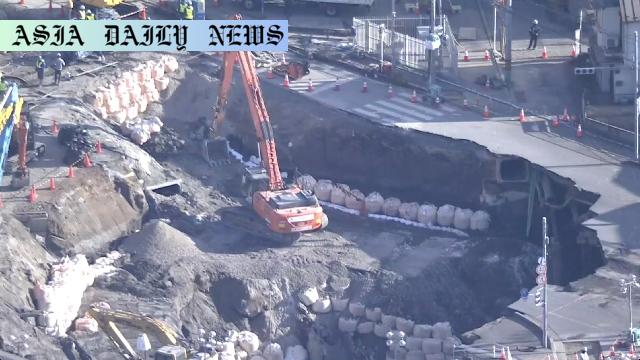Truck Driver: Authorities explore new options to locate driver missing after a sinkhole swallowed truck near Tokyo 2 weeks ago.
- Truck Driver remains missing after a vehicle fell into a sinkhole in Saitama Prefecture near Tokyo.
- Efforts to search using heavy machinery were stopped due to safety concerns about ground stability.
- Authorities are using monitoring holes to gain insight into underground pipe conditions.
- Plans to deploy rescue personnel into a sewage pipe are under consideration.

Missing Truck Driver and Sinkhole Incident
The sinking of a truck into a massive sinkhole in Saitama Prefecture near Tokyo two weeks ago has led to relentless efforts to locate its driver. Despite significant attempts, the driver remains missing, with authorities facing various challenges during the recovery mission. The incident occurred at a bustling intersection in Yashio city, a region now plagued with concerns about ground stability and public safety.
Challenges in the Rescue Operation
Efforts to retrieve the missing truck driver have been anything but straightforward. Firefighters initially launched a search mission and brought heavy machinery to the site. However, operations were suspended within minutes after fears arose about the possibility of further ground collapse. Such risks have significantly hampered the search, forcing the authorities to adapt their approach to ensure the safety of rescue workers and the surrounding area.
Current Monitoring Techniques and Future Plans
Saitama prefectural officials have since focused on developing alternative solutions to locate the missing driver. By creating two small monitoring holes on the ground surface—each about 10 centimeters in diameter—rescue workers can now observe conditions inside an underground sewage pipe around the clock. This monitoring strategy is seen as a crucial step in pinpointing the truck cab, which is believed to be wedged within the underground pipe system.
Further Strategies Under Consideration
In addition to monitoring, local authorities are exploring the possibility of deploying rescue personnel directly into the sewage pipe to conduct a hands-on search. However, the decision to send workers underground will depend heavily on the assessment of safety risks. Rescue teams must factor in the potential instability of the sinkhole region and the confined, hazardous environment within the pipe.
Statement from the Saitama Prefecture Governor
Saitama Governor Ono Motohiro addressed the ongoing rescue efforts in a public statement. He highlighted the importance of the monitoring holes, emphasizing that they provide essential visual access to the pipe’s interior. The visibility into the conditions of the truck cab and surroundings enables authorities to craft a more informed and cautious rescue strategy moving forward.
Public and Community Response
The sinkhole incident has garnered significant attention both locally and nationally, sparking concerns over urban infrastructure and public safety. Residents and commuters in the Yashio area are particularly unsettled, as the occurrence underscores vulnerabilities within the urban landscape. Many have called for thorough investigations to determine the sinkhole’s cause and ensure preventive measures are implemented to avoid future tragedies.
Broader Implications and Next Steps
This ongoing crisis highlights the necessity for robust urban planning and maintenance, especially in high-traffic regions such as Saitama’s busy intersections. Authorities are under pressure to maintain transparency throughout the investigation and rescue mission while expediting efforts to locate the missing truck driver. Moving forward, there is also a critical need to address infrastructural weaknesses to regain public trust and ensure enduring safety.
Conclusion
The search for the truck driver who went missing after the sinkhole incident is a somber reminder of the unpredictable dangers posed by infrastructure failures. Though progress has been slow and fraught with complications, the dedication of rescue teams and officials remains unwavering. As new investigative measures are rolled out, the hope persists that the driver can be located and lessons can be learned to prevent similar events in the future.



Commentary
The Importance of Urban Infrastructure Maintenance
The tragic story of the missing truck driver serves as a stark reminder of the critical role urban infrastructure plays in our daily lives. Sinkholes, though rare, can have severe consequences, not only endangering lives but causing widespread panic and disruption. This incident near Tokyo exposes vulnerabilities in effective city planning and the urgent need for routine inspections and maintenance in high-traffic areas.
Challenges Faced by Rescue Teams
Rescue operations in situations like this are inherently challenging. The decision to suspend searches due to ground instability highlights the complex balance between urgency and caution that must be maintained. These challenges further emphasize the importance of investment in advanced monitoring technologies and equipment that not only hasten recovery efforts but also safeguard rescuers’ lives.
Community Trust and Safety Concerns
For the residents of Yashio and surrounding areas, this incident is a source of deep concern. Public trust in infrastructure is essential for the functioning of any urbanized region, and events like these naturally raise questions about negligence or oversight. Authorities must act decisively not only in addressing immediate issues but also in communicating effectively to alleviate fears and reassure the community about their safety.
Long-term Implications
Looking ahead, this incident will hopefully act as a catalyst for stronger precautionary measures and infrastructure planning across Japan and globally. Urban authorities around the world must take note of such events and invest in preventive measures, ensuring that roads, pipes, and underground networks are designed to withstand the pressures of modern cities. Balancing growth with safety is no easy task, but it remains essential for sustainable urban development.